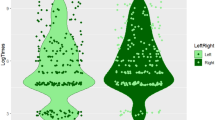Abstract
Honeybees Apis mellifera were trained to enter a Y-maze and choose the arm with a rewarded disc presented against a grey background. The alternative arm displayed the unrewarded grey background alone. Training and testing were performed with the rewarding disc subtending different visual angles. The training disc was either achromatic and provided green contrast, or chromatic and provided the same amount of green contrast as the achromatic one. The bee-achromatic disc could be learned and detected by the bees whenever it subtended 5° or 10°, but not if it subtended 30°. The chromatic disc was learned well and detected at all three visual angles. However, at 5° the maximum level of correct choices was ca. 75% with the achromatic disc whilst it was ca. 90% with the chromatic one. Thus, the presence of chromatic contrast enhances considerably the level of correct choices for the same amount of green contrast. The lower threshold of achromatic target detection lies between 3.7° and 5°; the upper threshold between 15° and 10°. At the upper threshold, detection switches from chromatic-based to achromatic-based. Thus, in the context of target detection, the achromatic green contrast channel specialises in the detection of objects of reduced angular size, whilst the chromatic channels are specialised for objects of large angular size. We suggest that achromatic detectors with a centre-surround organisation are involved in the task of detecting achromatic targets.
Similar content being viewed by others
Author information
Authors and Affiliations
Additional information
Accepted: 23 February 1998
Rights and permissions
About this article
Cite this article
Giurfa, M., Vorobyev, M. The angular range of achromatic target detection by honey bees. J Comp Physiol A 183, 101–110 (1998). https://doi.org/10.1007/s003590050238
Issue Date:
DOI: https://doi.org/10.1007/s003590050238




